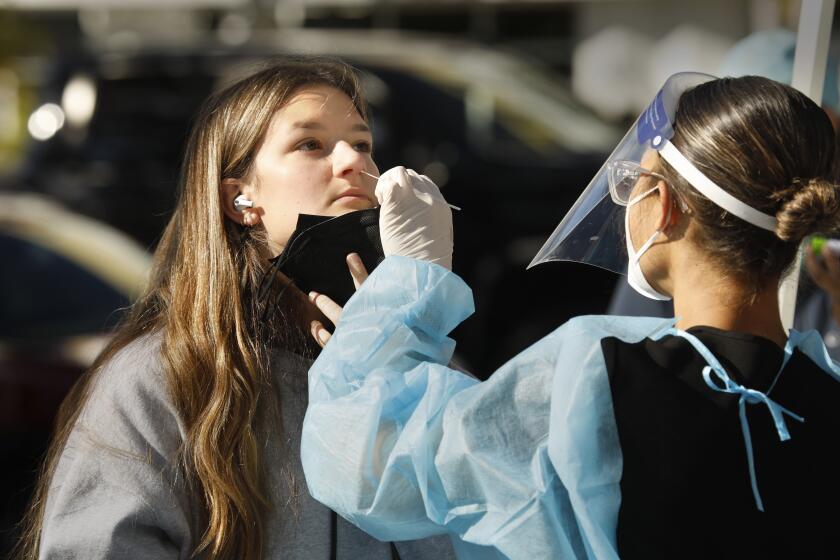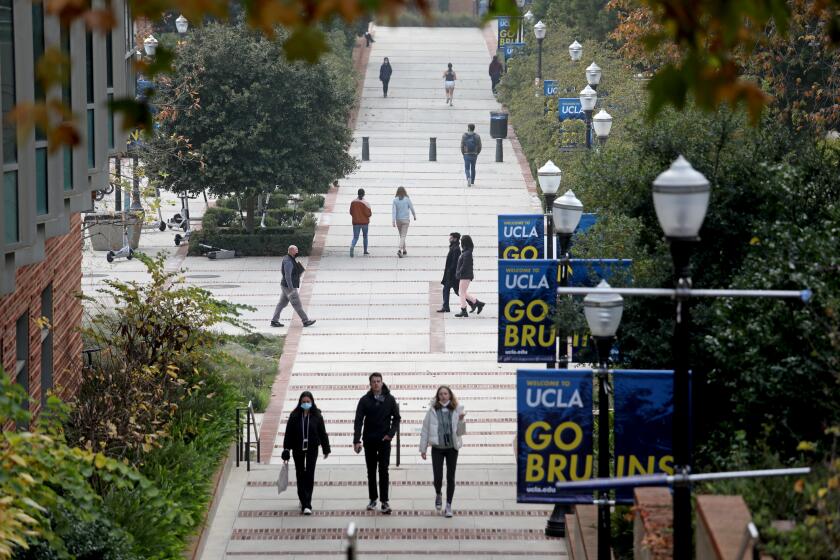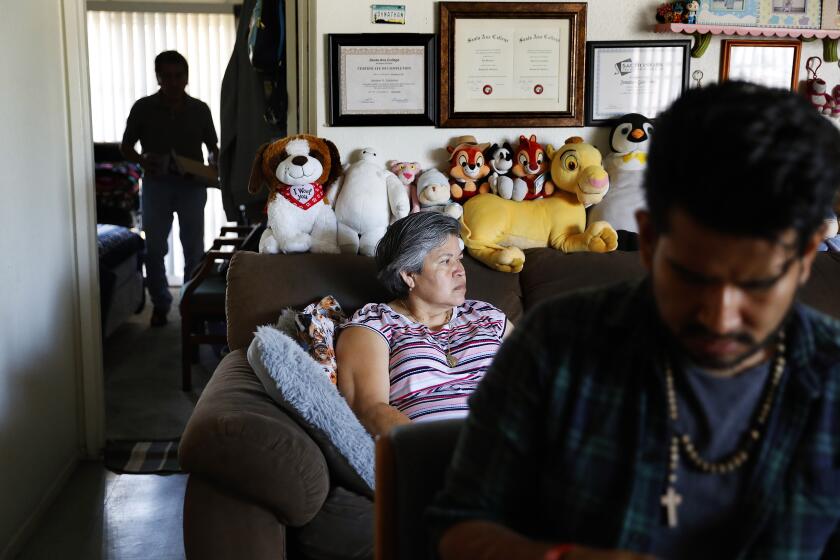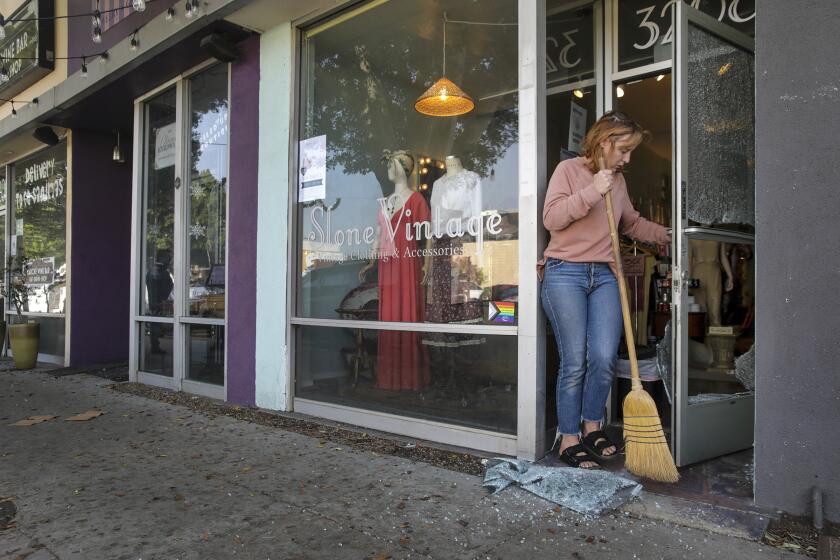COVID-19, children, climate change are focal points in Newsom’s budget plan
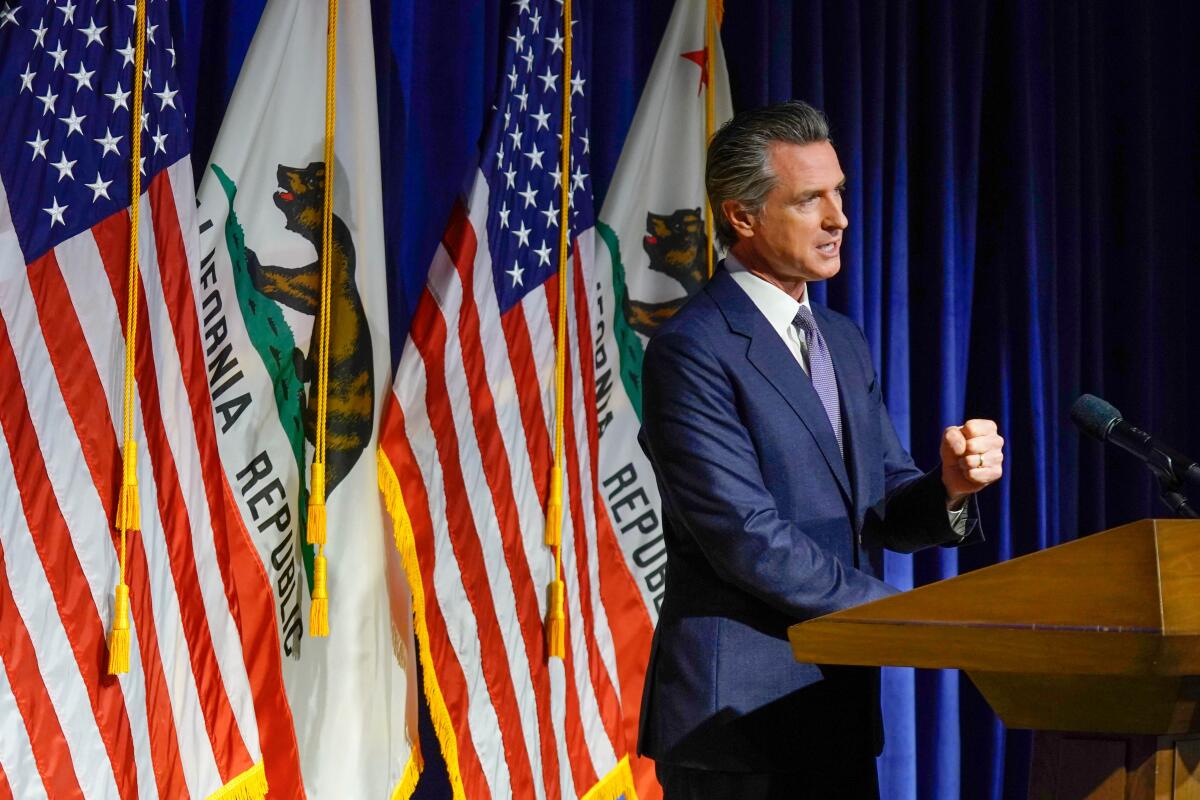
- Share via
SACRAMENTO — Built on projections of a ninth consecutive year of surplus tax revenue — a streak that has made California’s deficit-ridden past a distant memory — the $286.4-billion spending plan Gov. Gavin Newsom unveiled Monday builds on the state’s recent efforts to address the COVID-19 pandemic, homelessness and a worsening drought while surpassing K-12 school funding records set just last year.
In all, the governor’s plan lays out close to $10 billion in new spending on what a fact sheet from his office calls “five of California’s biggest challenges: COVID-19, climate change, homelessness, inequality, and keeping our streets safe.”
In broad terms, Newsom’s proposal to the Legislature is consistent with budgets written in recent years. Although it would direct surplus tax revenue toward the state’s cash reserves and pay down some long-term debts, there would be plenty left over for programs championed by the Democratic governor and legislators from both major parties — such as enhanced security at clinics that provide abortions and cancellation of an increase in California’s gas tax that was scheduled for July.
“We have the capacity to invest in our growth engines, invest in the future, as well as making sure that we prepare for the uncertainties that the future presents,” Newsom said at a news conference Monday.
Most of the plan covers spending in the fiscal year that begins July 1. But the governor is also asking legislators for immediate action to expand the state’s COVID-19 pandemic response, seeking authorization to quickly spend about half of a $2.7-billion budget proposal to boost testing, vaccinations and healthcare staffing across the state. Newsom also wants to bring back rules requiring California employers to provide COVID-19 sick leave for workers to recover or care for a family member, a statewide policy that expired last fall.
California would spend $2.7 billion on new efforts to respond to COVID-19 cases under a budget proposal Gov. Gavin Newsom will send to lawmakers next week.
A continued effort on the pandemic is one of several carryovers from last year in Newsom’s budget, his fourth since taking office in 2019. The spending plan also envisions significant new funding in response to the state’s homelessness crisis, calling for an additional $2 billion over a two-year period to get people out of encampments and into a shelter and to provide mental health services. The governor said last year’s efforts helped get 58,000 people off the streets, an important but preliminary step toward addressing the problem.
“I’m not naive,” he said. “I see exactly what you see, and that’s the need to do more and better. Because we still have tens of thousands of others struggling and suffering.”
The $2-billion proposal, according to administration officials, is an interim step while waiting for the completion of long-term housing options, financed by last year’s historic $12-billion state budget investment in homelessness assistance.
Other ideas are likely to surface in the coming months. Republican lawmakers asked the governor on Friday to convene a special legislative session on homelessness. Among the priorities listed in their letter to the governor, GOP lawmakers say the state needs to increase accountability for how and where funds have already been spent.
Newsom, whose budget presentation lasted almost three hours, said he expects community leaders to do their part, noting that local governments need to submit a “homelessness action plan” later this year.
“We are not going to fund failure,” he said. “We’re not going to fund folks that don’t provide those plans.”
The governor also hinted at something that wasn’t in the budget but he said he will recommend in the coming weeks: a far-reaching overhaul of the state’s conservatorship laws, a change that could force some unhoused individuals into treatment.
Newsom, who refused to offer additional details, said that the topic of removing someone from the streets “requires us to be a little bit uncomfortable” but that the state needs “a few more tools to help those that clearly can’t help themselves.”
Another $2 billion in the governor’s budget would be used to tackle California’s broader housing needs, providing housing grants and tax credits to spark the development of more places to live in downtown areas across the state. The outline he presented to lawmakers Monday says the effort would promote “a comprehensive and integrated climate and housing planning framework.”
The budget proposal released Monday makes a significant pledge to UC and CSU: the promise of long-sought financial stability.
Efforts to mitigate the impacts of climate change would also be boosted under the governor’s plan: $1.2 billion in new funds to lessen wildfire risk through better forest management, $648 million for firefighting and $750 million in drought relief for residents, agriculture and wildlife habitats.
State subsidies to encourage the purchase and use of zero-emission vehicles would sharply increase under Newsom’s budget — a $10-billion, six-year effort when coupled with actions taken last year. Rebates for electric vehicle buyers would expand, more money would be set aside for building charging stations and the state would earmark almost $3.5 billion for zero-emission school buses, transit buses and heavy-duty trucks that ship containers to and from ports.
A variety of proposals in the new spending plan are aimed at helping low-income families, with an emphasis on children. Newsom’s proposal would index the state’s $1,000 “Young Child Tax Credit” for inflation, allowing the annual subsidy to grow over time, beginning with the 2022 tax year. The budget also seeks to roll back a long-standing law that reduces child support payments to a parent who is a former recipient of government assistance, such as the state’s welfare-to-work program, CalWORKs. Doing so would lower government recoupment receipts by $187 million.
Still, advocates urged Newsom and lawmakers to do more.
“One in 8 children in California depends on a local child support agency to deliver the dollars that sustain their food, clothing, shelter and healthcare,” said Greg Wilson, executive director of the Child Support Directors Assn. of California. “While state revenues have soared to unprecedented heights, California children and families face a relentless epidemic of child poverty.”
The state’s lowest-income earners receive healthcare services through Medi-Cal, which is projected to offer coverage to 14.2 million Californians by later this year — some 36% of all state residents.
Few changes to the program are likely to receive as much attention as Newsom’s embrace of what many legislative Democrats have wanted for several years: Medi-Cal eligibility for any resident, regardless of immigration status, who qualifies based on income. Current law offers Medi-Cal coverage to immigrants up to age 26 and, as of May 1, those age 50 and older. The final group of immigrants, those in their 30s and 40s, will be eligible under Newsom’s plan in 2024.
Low-income Californians 50 and older will be eligible for healthcare regardless of immigration status under a law extending benefits to 235,000 residents in the country illegally.
Child-care services would expand under the plan, including additional subsidized child-care slots and a rate increase for child-care providers — in part driven by last summer’s agreement to recognize a new union representing caregivers.
As with most state budgets, constitutional requirements enacted by voters give K-12 schools and community colleges the single largest portion of general fund dollars. Newsom’s plan projects $119 billion in education funding — almost equal to all state budget spending in 2011-12. Across all funding sources, per-pupil spending in California would rise to $20,855, with more dollars from the state’s general fund than ever before.
The budget sent to lawmakers Monday would provide more than $600 million in new funding for the University of California and California State University campuses, combined, above current general fund support. Both systems are expected to increase the number of in-state students, and the budget would add more money for scholarships aimed at students from middle-class families.
Not all proposals in the governor’s budget plan are a continuation of prior efforts. Following a recent surge in retail theft across California, Newsom has launched a new plan to boost law enforcement efforts. This includes funding for what his administration calls “a smash-and-grab enforcement unit,” grants for small businesses that have been affected and state-level prosecution if local district attorneys choose not to act.
Gov. Gavin Newsom says his budget proposal will include $270 million in anti-crime grants and $25 million for small businesses victimized by theft.
A sizable number of credits and other tax breaks are included in the proposal. None are larger than a proposal to reinstate the state’s “net operating loss” tax deduction for businesses, suspended in 2020 because of fears of a pandemic-induced budget deficit. Resuming the deduction, along with a series of other business tax credits, would cost the state $5.5 billion in 2022-23.
Though the governor’s budget is stocked with ambitious new proposals, the enormity of the projected tax surplus may again overshadow any singular effort. State budget officials estimate the total surplus — one they define as all unexpected money, even funds required to be spent on schools or placed in cash reserves, at $45.7 billion between now and next summer. But lawmakers would have discretion on how to spend a little less than half that amount.
They must also decide how to respond to Newsom’s projections that final tax revenue calculations for the current budget year and the one that ended last June will, combined, surpass California’s constitutional limit on spending. The governor’s budget director said Monday that at least $2.6 billion in taxes collected could be subject to the 42-year-old spending limit’s rules of either diverting money to expenses that are exempt from the limit or splitting the excess cash between schools and taxpayer rebates.
Times staff writers Hannah Wiley and Mackenzie Mays contributed to this report.
More to Read
Sign up for Essential California
The most important California stories and recommendations in your inbox every morning.
You may occasionally receive promotional content from the Los Angeles Times.
